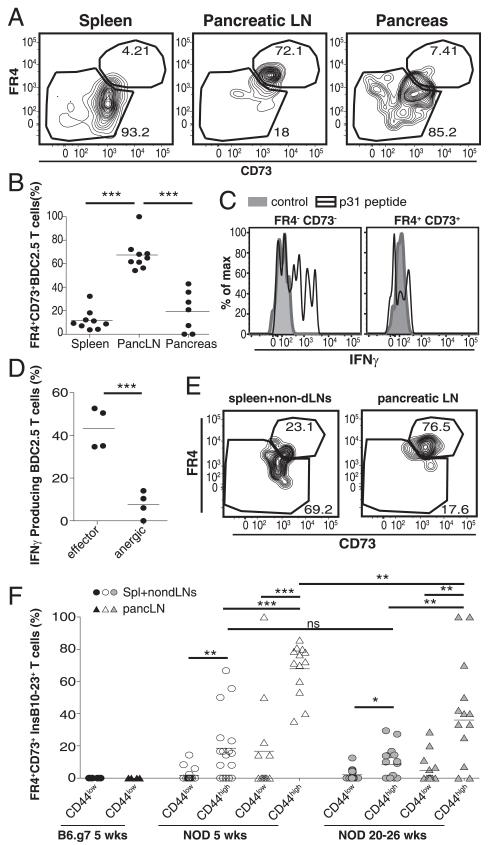FIGURE 4.
Anergy is induced in islet-reactive CD4+ T cells in NOD mice but not B6.g7 mice. (A) FR4 and CD73 expression on BDC2.5 T cells 17 d posttransfer. (B) Quantification of anergic BDC2.5 T cells in the spleen, pLNs, and pancreas 17–26 d posttransfer to nondiabetic NOD mice from three experiments. (C) IFN-γ production by effector (FR4−CD73−) and anergic (FR4+CD73+) phenotype BDC2.5 T cells in the pLNs at 56 d posttransfer. (D) Frequency of IFNg+ BDC2.5 T cells in the pLNs at 56 d posttransfer. Data in (C) and (D) are representative from three experiments (n = 3–4). (E) FR4 and CD73 on insulin-specific CD4+ T cells from a 5-wkold nondiabetic NOD mouse. (F) Frequency of anergic phenotype (Foxp3−FR4+CD73+) insulin-specific CD4+ T cells in the spleen+non-dLNs (circles) and the pLNs (triangles) from 5-wk-old B6.g7 mice (black, n = 6), 5-wk-old nondiabetic NOD mice (white, n = 17), and 20–26-wk-old nondiabetic NOD mice (gray, n = 17). Insulin-specific CD4+ T cells were further gated on CD44high versus CD44low cells. Data are compiled from six experiments. Cells are gated on singlet+, CD3+, B220−, CD11b−, CD11c−, CD4+, Foxp3− cells. Data in (A)–(D) also include Thy1.1+, CD44high cells, and data in (E) and (F) also include InsB10–23r3:I-Ag7 PE+ and allophycocyanin+ tetramers. *p = 0.01–0.05, **p = 0.001–0.01, ***p < 0.001. ns, Not significant.

